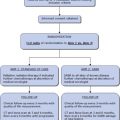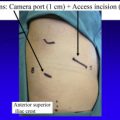Targeted therapy and immunotherapy have changed the treatment paradigm of non–small cell lung cancer (NSCLC). Distinct molecular subtypes of NSCLC have been described over the past 20 years, enabling the emergence of treatments specific to that subtype. Agents targeting the driver mutations in NSCLC have revolutionized the approach to patients with metastatic disease, because oncologists now select a treatment based on the profile of that particular tumor. More recently, an understanding of immune checkpoints has led to the development of checkpoint inhibitors that enable the host immune system to better recognize tumor cells as foreign and to destroy them.
Key points
- •
Targeted therapy and immunotherapy have had an increasing role in the management of patients with advanced non–small cell lung cancer (NSCLC).
- •
Therapies targeting patients with epidermal growth factor receptor (EGFR) mutations and anaplastic lymphoma kinase (ALK) rearrangements have proved most successful, whereas others specific for additional genetic alterations seem promising.
- •
Immunotherapy in lung cancer, primarily through checkpoint inhibition, permits the activation of tumor-specific T cells often suppressed by cancer cells.
- •
Adverse effects of these drugs are often mild and manageable, improving quality of life and limiting cumulative toxicity seen with use of cytotoxic chemotherapy.
Introduction
The management of patients with advanced NSCLC has evolved dramatically over the past decade. Therapeutic options were previously limited to cytotoxic chemotherapy in a 1-size-fits-all approach. As more information becomes known about the driving molecular events behind tumorigenesis, however, researchers are designing drugs capable of interfering with these events in a more individualized approach. The first such drugs in NSCLC were the targeted agents, biologic compounds that interact with cell surface receptors or their downstream partners critical in cancer development. These agents have shown a monumental benefit in a small number of patients with NSCLC. The more recent addition has been the immunotherapeutic agents, which seem to have a broader benefit and are providing durable responses in NSCLC not previously seen.
Introduction
The management of patients with advanced NSCLC has evolved dramatically over the past decade. Therapeutic options were previously limited to cytotoxic chemotherapy in a 1-size-fits-all approach. As more information becomes known about the driving molecular events behind tumorigenesis, however, researchers are designing drugs capable of interfering with these events in a more individualized approach. The first such drugs in NSCLC were the targeted agents, biologic compounds that interact with cell surface receptors or their downstream partners critical in cancer development. These agents have shown a monumental benefit in a small number of patients with NSCLC. The more recent addition has been the immunotherapeutic agents, which seem to have a broader benefit and are providing durable responses in NSCLC not previously seen.
Targeted agents
Background
Several genetic alterations have been identified as drivers of tumorigenesis in NSCLC. Among the most important described in lung cancer is the ERK-MAPK cascade. In this cascade, activating mutations in EGFR, RAS, and BRAF found in lung cancer lead to malignant transformation and gene expression changes. Patients with KRAS-mutant tumors, accounting for 25% of cases of adenocarcinoma, are often predictive of a lack of benefit of tyrosine kinase inhibitors (TKIs) and associated with poorer overall survival.
The number of therapeutic targets is rapidly growing. Fortunately, the drugs being developed for these targets generally have more favorable toxicity profiles than cytotoxic chemotherapy ( Table 1 ).
| Class | Drugs | Adverse Effects |
|---|---|---|
| EGFR inhibitors | Erlotinib, afatinib, gefitinib, osimertinib, rociletinib | Rash, diarrhea, anorexia, fatigue, dyspnea, cough, nausea, vomiting, interstitial lung disease, hepatotoxicity |
| ALK inhibitors | Crizotinib, ceritinib, brigatinib, alectinib | Vision disorder, diarrhea, edema, transaminase elevations, vomiting, constipation, dysgeusia, fatigue, pyrexia, pain in extremity, headache, dizziness, pneumonitis |
| BRAF inhibitors | Vemurafenib, dabrafenib | Other malignancies, hypersensitivity reactions, dermatologic reactions, QT prolongation, hepatotoxicity, uveitis, radiation recall/sensitivity, arthralgia, rash, alopecia, photosensitivity, nausea, pruritis |
| MEK inhibitors | Trametinib, cobimetinib | Hemorrhage, rash, cardiomyopathy, hepatotoxicity, retinopathy and retinal vein occlusion, rhabdomyolysis, diarrhea, photosensitivity, nausea, pyrexia, vomiting |
| HER2-blocking antibodies | Trastuzumab | Headache, diarrhea, nausea, chills, cardiomyopathy, infusion reactions, pulmonary toxicity |
| Multitargeted kinase inhibitors | Cabozantinib | Gastrointestinal perforation/fistula, hemorrhage, thrombotic events, wound complications, hypertension, hand-foot syndrome, osteonecrosis of the jaw, proteinuria, diarrhea, stomatitis, weight loss, anorexia, dysgeusia, nausea, fatigue |
Epidermal Growth Factor Receptor Mutations
The cell surface receptor EGFR, when dimerized, activates tyrosine kinases. This action contributes to control of normal cell proliferation, angiogenesis, adhesion, motility, and apoptosis. Loss of this control contributes to the malignant potential of a lung cancer cell.
Mutations in EGFR account for 15% of lung adenocarcinoma in the United States, the most common of which occur in exon 19 (exon 19del) and exon 21 (L858R). Women and nonsmokers have a slightly higher likelihood of mutations. The frequency of EGFR mutations in various Asian populations increases to 22% to 62% of NSCLCs.
Four EGFR TKIs, erlotinib (Tarceva), gefitinib (Iressa), afatinib (Gilotrif), and osimertinib (Tagrisso), are currently Food and Drug Administration (FDA) approved and in clinical use in the United States. Compared with standard cytotoxic chemotherapy doublets, this class of drugs has proved to prolong progression-free survival (PFS) in patients with advanced NSCLC with activating EGFR mutations.
Gefitinib showed an impressive improvement in PFS compared with carboplatin (Paraplatin) and paclitaxel (Taxol) in the Iressa Pan-Asia Study trial in 2009. In this study, PFS was doubled with gefitinib at 10.8 months compared with 5.4 months for the standard cytotoxic chemotherapy doublet. This study enrolled unselected Asian patients with a higher frequency of EGFR mutations than that seen in a Western population. Despite these impressive results and its extensive clinical use in Asia, gefitinib use has been limited in the United States until FDA approval in 2015. Gefitinib is approved for patients whose tumor contains an EGFR exon 19 deletion or exon 21 L858R.
Erlotinib was also compared with standard cytotoxic chemotherapy in clinical trials. In the OPTIMAL trial, an impressive improvement in PFS of 8 months was noted when erlotinib was compared with gemcitabine (Gemzar) plus carboplatin. Similar improvements in PFS of 5 to 6 months were found in the EURTAC and ENSURE trials. Despite these improvements in PFS, no statistically significant difference in overall survival was found in either trial comparing erlotinib to standard cytotoxic chemotherapy, likely due to crossover of therapy after progression.
Afatinib is as an oral irreversible inhibitor of EGFR and HER2. In the LUX-Lung 3 trial, afatinib showed a significant increase in PFS of 6.7 months compared with cisplatin (Platinol) and pemetrexed (Alimta) in treatment-naïve patients with EGFR exon 19 deletions and L858R point mutations. Notably, 4 treatment-related deaths were seen with afatinib as opposed to none with chemotherapy. Afatinib is FDA approved for first-line treatment of patients with metastatic NSCLC whose tumors have EGFR exon 19 deletions or exon 21 substitution mutations. Activity after failure of erlotinib or gefitinib is limited, with only a 7% response rate.
An EGFR T790M mutation in exon 20 is associated with acquired resistance to TKI therapy and has been reported in up to 63% of patients with disease progression after initial response to front-line TKIs. Osimertinib and rociletinib are third-generation EGFR inhibitors active in preclinical models of EGFR T790M-mutated NSCLC. In separate studies of patients whose disease had progressed on EGFR-directed therapy, the objective response rate among T790M-positive disease was approximately 60% and the rate among patients with T790M-negative disease was 20% to 30%.
EML4-ALK Translocations
Translocation of ALK and Echinoderm Microtubule-Associated Protein-Like 4 (EML4) from an inversion of the short arm of chromosome 2 results in a fusion protein EML4-ALK that activates several pathways driving cell survival and proliferation. These translocations are present in 3% to 5% of NSCLC patients and define a distinct subset of lung cancer patients.
Crizotinib (Xalkori) is an oral inhibitor of ALK, MET, and ROS1 kinases. In patients with treatment-naïve advanced ALK-positive NSCLC in PROFILE 1014, crizotinib performed better than cytotoxic chemotherapy, with median PFS of 10.9 months versus 7.0 months, a response rate of 74% versus 45%, and improvements in lung cancer symptoms and quality of life. Overall survival was not significantly different, likely owing to a 70% crossover rate on progression in the chemotherapy arm.
Ceritinib (Zykadia) produces a high response rate of 55.4% in patients previously treated with crizotinib and 69.5% in patients naïve to ALK inhibitors. Patients with prior exposure had a meaningful 6.9 month PFS on ceritinib. Two other ALK inhibitors, brigatinib (AP26113) and alectinib (Alecensa), have also shown promising activity in patients with progression on crizotinib, including patients with brain metastases.
ROS1 Rearrangements
ROS1 is a tyrosine kinase receptor of the insulin receptor family. At least 12 different partner proteins form fusions with ROS1, producing constitutive kinase activity, thereby driving cellular transformation. Rearrangements of ROS1 are found in 1% to 2% of NSCLC specimens and are more common in patients with a light or no smoking history and those with adenocarcinoma.
Crizotinib has been shown to induce responses in vitro and in limited experience in patients with ROS1 rearrangements. A recent phase I clinical trial supported these data, showing a high response rate of 72%, with 6% of patients achieving complete responses. Furthermore, median PFS was 19.2 months, and all ROS1 fusions showed a benefit.
BRAF V600 Mutations
BRAF mutations are identified in approximately 2% of lung adenocarcinoma tumors. Twenty patients with NSCLC harboring a V600 mutation received treatment with vemurafenib (Zelboraf), resulting in a 42% response rate in evaluable patients and a median PFS of 7.3 months. Dabrafenib (Tafinlar) also demonstrated activity in 17 patients with BRAF V600E mutations, with an overall response rate of 54%. A retrospective study of patients with BRAF mutations revealed a similar response rate of 53% and PFS of 5 months in patients treated with various BRAF inhibitors.
Combination therapy with dabrafenib and trametinib (Mekinist) yielded an impressive 63% response rate in 24 evaluable NSCLC patients harboring a BRAF V600E mutation.
MET Amplification or Exon 14 Skipping Mutation
The proto-oncogene MET, also known as hepatocyte growth factor receptor, is involved in signal transduction. MET exon 14 splice site alterations and other mutations have been shown to result in exon skipping and MET activation and are present in approximately 3% of lung adenocarcinoma and 2.3% of other lung neoplasms. These alterations result in tumor cell proliferation, invasion, and metastasis.
A phase I study of patients with MET-amplified NSCLC treated with crizotinib revealed a response rate of 33%, perhaps better in those with high amplification, defined as MET/CEP7 ratio of 5 or greater. Those harboring MET exon 14 skipping mutations have shown responses to both crizotinib and cabozantinib. Additionally, the investigational MET inhibitor capmatinib (INC280) induced partial responses in several patients in phase I clinical trials.
RET Rearrangements
Rearrangements or fusions of RET, a proto-oncogene encoding a tyrosine kinase involved in extracellular signaling, are identified in 1% to 2% of NSCLCs, primarily adenocarcinoma in nonsmokers. Twenty patients with adenocarcinoma harboring RET rearrangements were treated in a phase II open-label trial with the multi-TKI cabozantinib (Cometriq). The investigators noted an overall response rate of 28% and stable disease in 72%. Median PFS was 7 months.
HER2 Mutations
HER2 mutations are the driver mutations found in approximately 2% of NSCLCs. These mutations are primarily found in women, never-smokers, and almost exclusively adenocarcinoma histology. In-frame insertions in exon 20 lead to constitutive activation of the HER2 receptor, and its downstream signaling pathways, in turn driving neoplastic transformation.
Trastuzumab (Herceptin) and afatinib have yielded partial responses and disease control in patients with HER2-mutated NSCLC.
Recommended Testing
Based on these data, the National Comprehensive Cancer Network guidelines for NSCLC (version 2.2016) recommend all patients with metastatic NSCLC of histologic subtypes adenocarcinoma, large cell carcinoma, and NSCLC not otherwise specified be tested for EGFR mutations and ALK rearrangement as part of broad molecular profiling. Patients with squamous cell carcinoma can be considered for testing, especially in never-smokers, mixed histology, or small biopsy specimens. At this time, the data do not support routine testing of patients treated with curative intent. The College of American Pathologists recommends routine testing for all patients, including resectable NSCLC.
Stay updated, free articles. Join our Telegram channel

Full access? Get Clinical Tree






